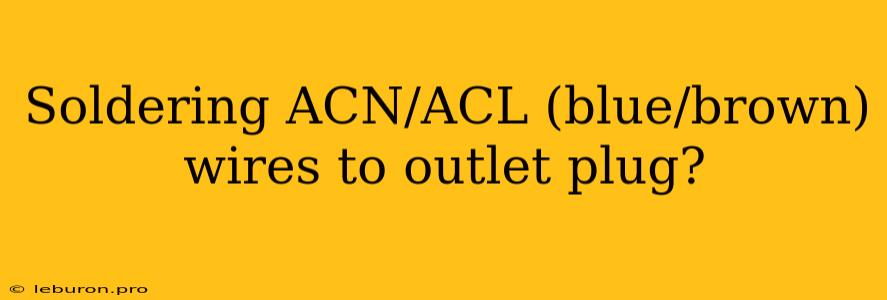Soldering ACN/ACL (Blue/Brown) Wires to an Outlet Plug: A Comprehensive Guide
Soldering ACN/ACL (blue/brown) wires to an outlet plug is a crucial step in electrical installations. This process requires precision and adherence to safety guidelines to ensure proper functioning and avoid electrical hazards. This guide aims to provide a comprehensive overview of the process, from understanding the components involved to executing the soldering steps correctly.
Understanding the Components
Before we delve into the soldering process, it's essential to understand the components involved.
1. ACN/ACL (Blue/Brown) Wires:
- ACN (Blue): Represents the neutral wire, carrying the return current back to the source.
- ACL (Brown): Represents the live wire, carrying the electrical current from the source.
2. Outlet Plug:
- Earth (Green/Yellow): Provides a path for fault currents to flow directly to ground, preventing electrical shock.
- Live (Brown): Connects to the live wire from the source.
- Neutral (Blue): Connects to the neutral wire from the source.
3. Soldering Iron:
- Tip: The heated part that melts the solder.
- Heating Element: Provides heat to the tip.
- Temperature Control: Allows adjustment of the tip's temperature for different soldering tasks.
4. Solder:
- Flux: A chemical that cleans the surfaces of the wires and the plug terminals, allowing for a better solder connection.
- Lead: The metal that melts and solidifies to create the electrical connection.
5. Tools:
- Wire Strippers: To remove the insulation from the wires.
- Wire Cutters: To cut the wires to the appropriate length.
- Pliers: For holding and bending the wires.
- Heat Sink: To protect components from overheating during soldering.
Safety Precautions
- Disconnect Power: Always disconnect power from the outlet before working on it.
- Wear Safety Glasses: Protect your eyes from potential solder splatters.
- Use Insulated Tools: Avoid contact with live wires.
- Use a Heat Sink: Prevent overheating of nearby components.
- Do Not Overheat: Avoid excessive heat on the wires and plug terminals.
Step-by-Step Soldering Process
1. Prepare the Wires and Plug:
- Strip Wires: Using wire strippers, remove approximately 1/2 inch of insulation from the ends of the ACN (blue) and ACL (brown) wires.
- Clean Terminals: Clean the terminals of the outlet plug with a wire brush or sandpaper to ensure a good connection.
2. Apply Flux:
- Apply Flux: Apply a thin layer of flux to the exposed wire ends and the plug terminals.
3. Solder the Wires to the Plug:
- Heat the Tip: Heat the soldering iron tip to the appropriate temperature for the type of solder being used.
- Apply Solder: While holding the wire firmly, apply a small amount of solder to the exposed wire end and the corresponding terminal.
- Melt the Solder: Melt the solder by bringing the heated tip close to the wire and terminal, ensuring good contact.
- Remove the Tip: Remove the tip when the solder flows smoothly and forms a solid connection.
- Repeat: Repeat this process for the remaining wires and terminals.
4. Inspect the Connections:
- Check for Soldering Bridges: Inspect the connections to ensure there are no solder bridges between adjacent wires.
- Test Connections: Use a multimeter to test the continuity of the connections between the wires and terminals.
5. Install the Plug:
- Secure Connections: Ensure all connections are secure and properly insulated.
- Attach the Cover: Attach the cover to the outlet plug.
- Connect Power: Carefully connect the outlet plug to the power source.
Tips and Recommendations
- Use High-Quality Solder: Choose solder with the appropriate melting point and flux for electrical applications.
- Use a Heat Sink: Protect nearby components from excessive heat during soldering by using a heat sink.
- Avoid Overheating: Overheating can damage the wires and terminals.
- Inspect Regularly: Inspect the soldered connections regularly for signs of wear or damage.
Conclusion
Soldering ACN/ACL (blue/brown) wires to an outlet plug is a fundamental skill in electrical installations. By understanding the components, following safety precautions, and applying the correct soldering techniques, you can ensure safe and reliable connections. Remember to always disconnect power before working on electrical equipment and to seek professional assistance for any complex or questionable installations.
